In this article, we’ll review the 10 best Jira alternatives, going over their pricing, features, pros, and cons to help you make an informed decision.
Before we dive into it, we want to go over some of the reasons why some users are looking for Jira alternatives. 👇
Why You Might Look For Jira Alternatives?
Jira is a project management tool used by software development teams that helps you plan, track, and manage your projects by creating and organizing tasks and issues.

The project management tool can be embedded in:
- Teams: Receive instant notifications about updates about your Jira issues status and trigger automated actions on Jira based on events within Microsoft Teams.
- Slack: Create Jira Issues directly within conversations and resolve issues directly within the context of your Slack conversation.
Even though all of these features seem good at first glance, we found a few complaints from verified customers of the platform: 👇
#1: The Platform Reportedly Has A Steep Learning Curve
We found some verified users of Jira who note how steep the learning curve of Jira is and how its feature set may overwhelm a new user.
The users of the platform claim that a customer would need technical expertise to configure the platform and to perform in general.

“Jira is a steep learning curve itself, and its feature set may immediately overwhelm a new user. Advanced configurations of most of the configurations are really challenging to perform and usually require technical expertise.'' - G2 Review.
#2: Not Ideal For Teamwork
Some verified users of Jira have complained that the project management tool doesn’t easily allow tasks to be linked.
There are complaints about working in a team and using Jira as the platform does not easily allow tasks to be linked between individuals working together in a team setting.

“Jira does not easily allow tasks to be linked, or for multiple people to own a single task if working in tandem.'' - G2 Review.
#3: The Free Plan Has Limited Functionality
Lastly, we found a review of the limitations of Jira’s functionalities in its free plan in comparison to other platforms on the market.
According to G2 reviews, some customers had to upgrade to a paid tier to get the functionality they needed out of the platform for their small team.

‘’The free version of Jira has many limitations.’’ - G2 Review.
What Are The Best Jira Alternatives On The Market In 2025?
Here’s a breakdown of the best alternatives to Jira in 2025:
#1: SmartSuite - Best for managing every part of your work processes in a centralized platform with built-in automations.
#2: Wrike - Best for enhancing productivity and streamlining workflows.
#3: Monday.com - Best for customers looking for a visually intuitive interface to manage tasks and projects.
#4: Basecamp - Best for simplistic team collaboration and remote work management.
#5: Asana - Best for organizing tasks and tracking progress through customizable project boards and real-time collaboration.
#6: Hive - Best for streamlining task management and collaboration.
#7: Notion - Best for documentation, project planning, and team communication.
#8: ClickUp - Best for managing all work tasks in one place.
#9: Trello - Best for visual task organization and collaboration.
#10: Workzone - Best for teams looking to improve their project management and collaboration processes.
#1: SmartSuite
SmartSuite offers the best Jira alternative on the market in 2025 with its all-in-one project management suite that lets you manage every part of your work processes in a centralized platform with built-in automations.

Full disclosure: Even though SmartSuite is our project management platform, we will provide an honest perspective on why SmartSuite is truly the top Jira alternative available.
The reason why we believe that SmartSuite is the best Jira alternative is because the platform checks all the right boxes for the key features you need in a project management platform.
Below are some of SmartSuite’s stand-out features: ⤵️
Plan, Track & Manage Simple To Complex Projects
SmartSuite’s project management suite of features helps teams plan, track, and manage multiple projects at scale.
To simplify the process, your team will get numerous built-in intuitive features to execute your tasks perfectly.
Here are the features that technical teams who normally use Jira love the most about SmartSuite:
- Smart task management: You can turn any item field into a task—a checklist item, comments, or sub-item. Your team can easily build a solid task list and assign it to the right person with a due date and priority status.
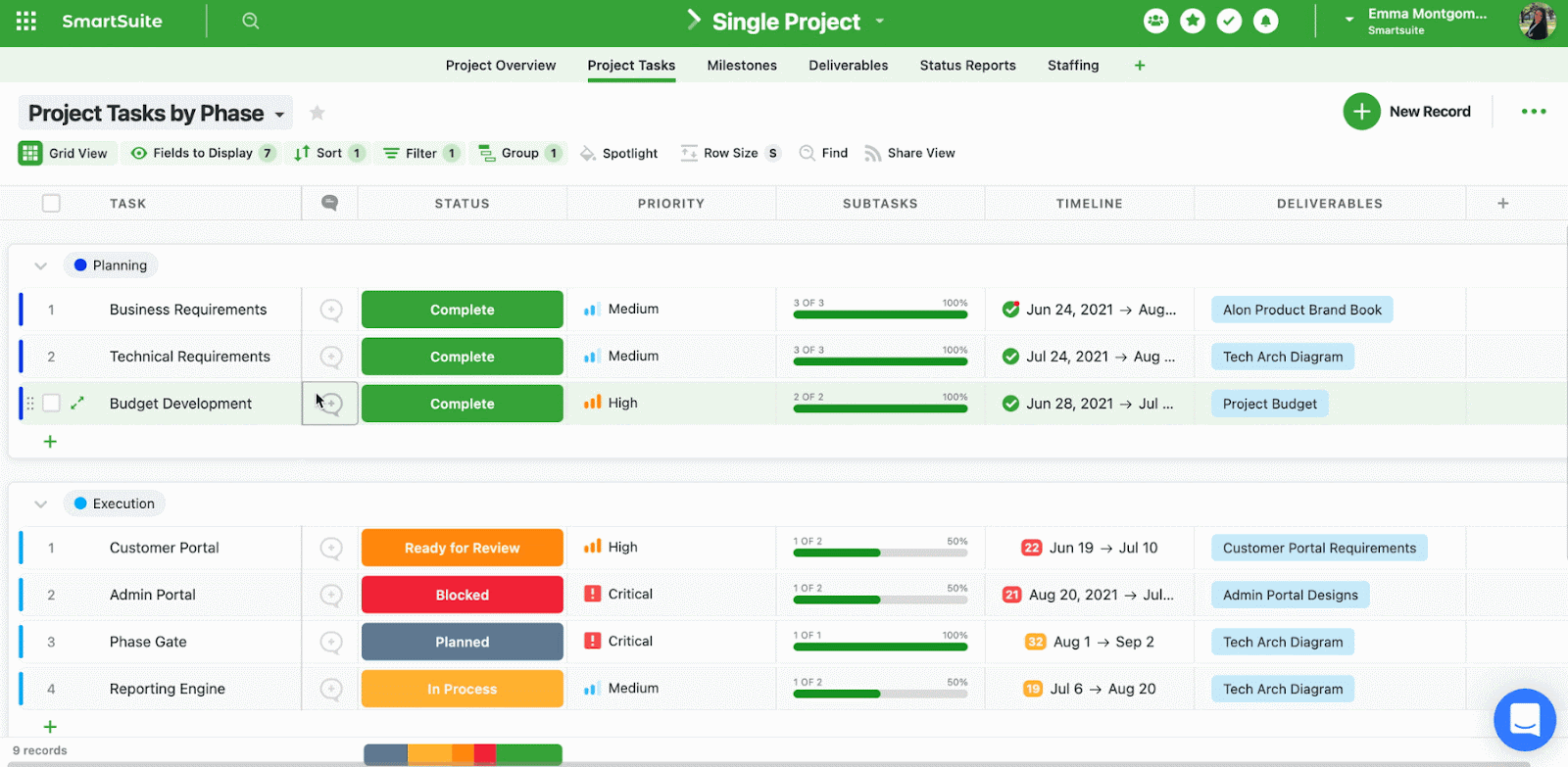
- Project phases and milestones: Having milestones ensures your project stays on track and moves towards the objective. With SmartSuite, your team can set them, monitor through your reporting dashboard, and flag issues.
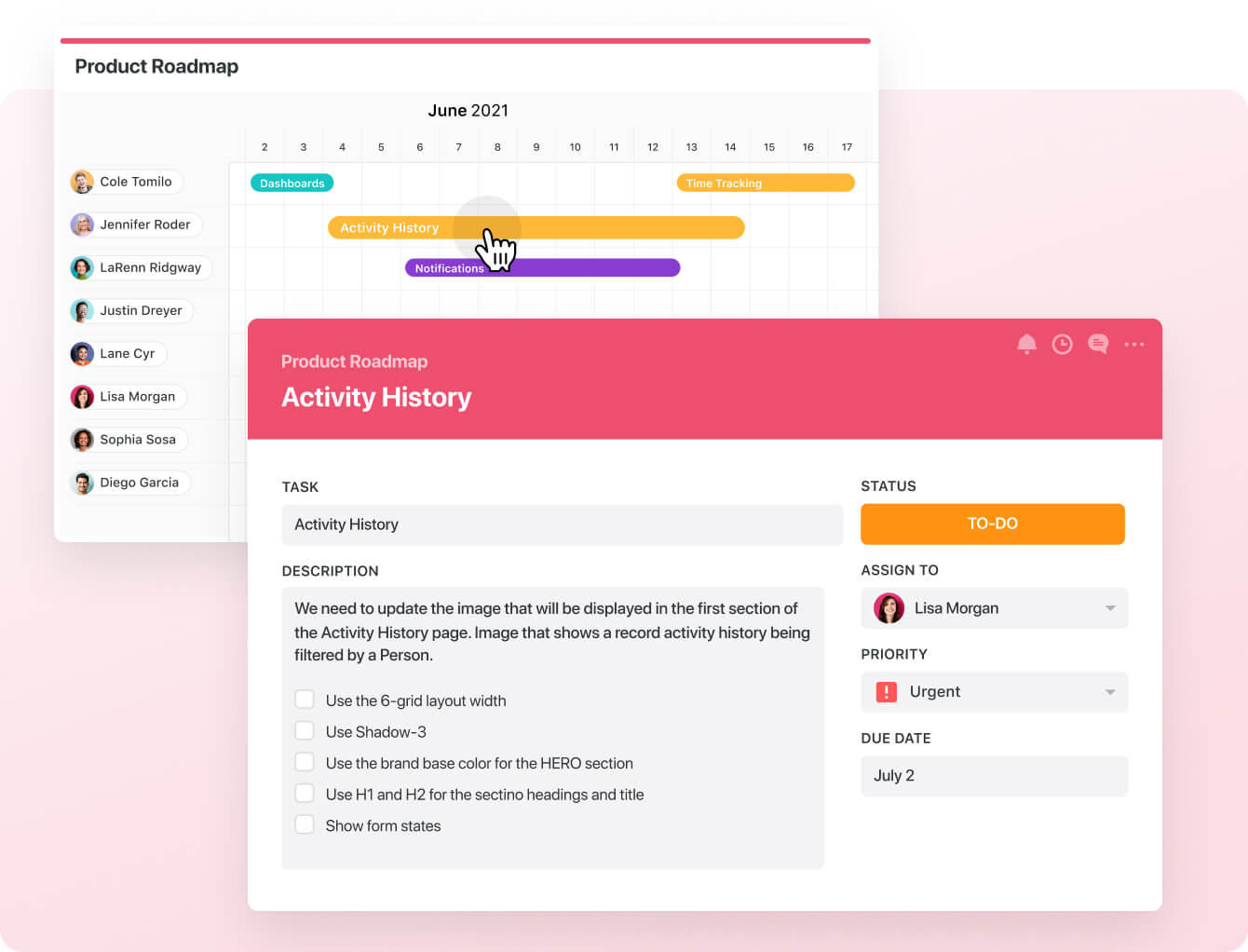
- Files and project deliverables: Manage and organize all your documents. It is also possible to attach project-related files, share feedback with your team, and manage version history, all within your work context.
💡 SmartSuite supports formats like PDF, GIF, CSV, PNG, and MP4 and integrates with Dropbox, Google Drive, Box, and Microsoft OneDrive, making adding files to your workflows easy.
It is also possible to add images directly in SmartSuite by connecting your social media and Unsplash accounts.

- Native time tracking: Your team can monitor and evaluate task and project completion times. Built-in tracking helps group time entries see estimates and segment billable and non-billable entries.
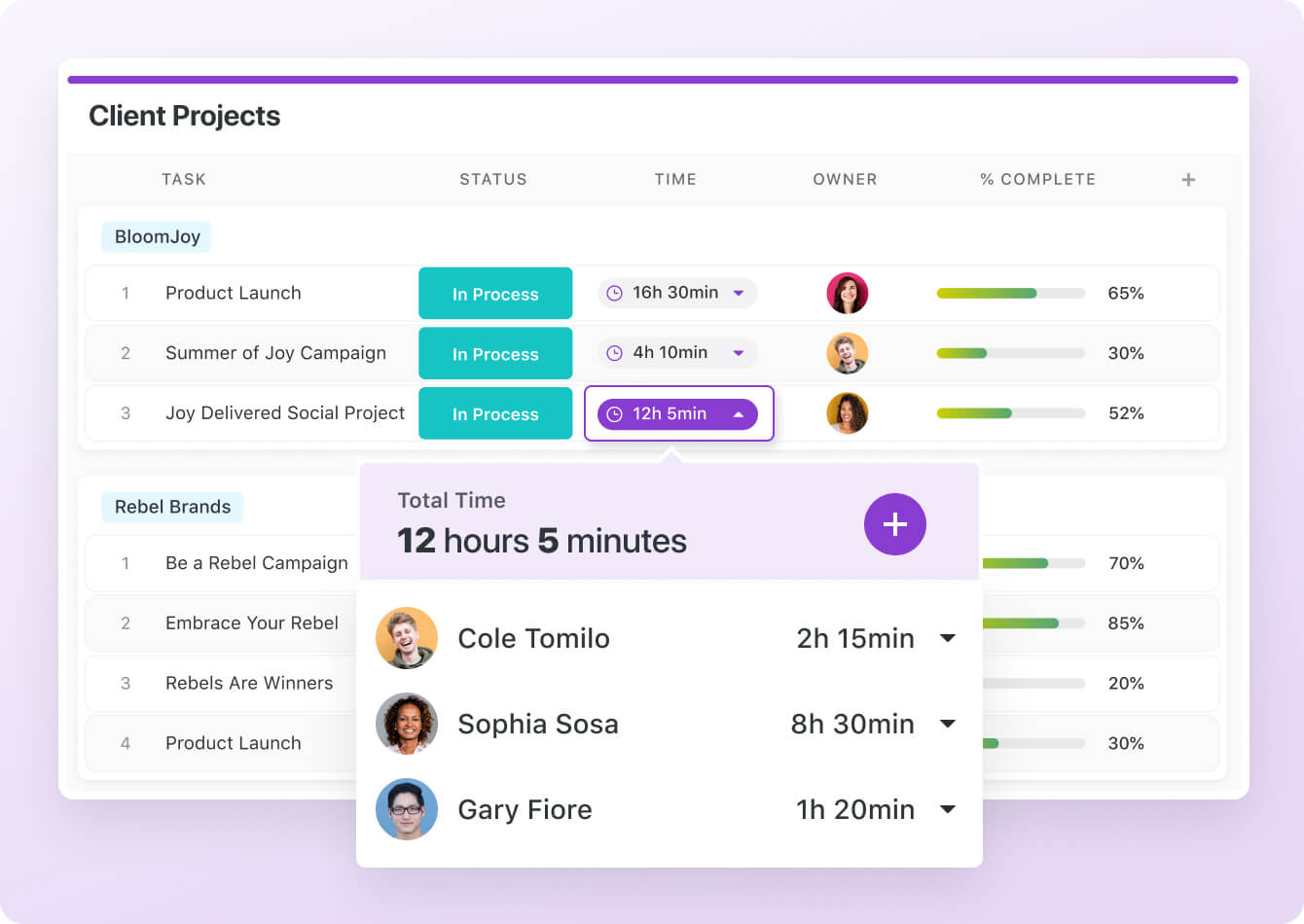
Team collaboration
SmartSuite offers built-in communication and collaboration features that allow you to connect with clients and team members in group chats or 1:1 conversations for quick feedback.

SmartSuite’s members’ directory provides a holistic view of the project team by examining each teammate’s details, such as availability status, job profile, and other relevant information.
Like the other two tools, you can use comments and @mentions to share updates, nudge teammates, or add new people to the conversation.

Comprehensive project reporting
Our platform has a dynamic project analytics tool with configurable charts and graphs.
The reporting dashboard helps you track project performance, understand resource allocation, and identify slow-moving projects.
Based on that information, you can quickly develop plans to overcome roadblocks and get the project back on track.
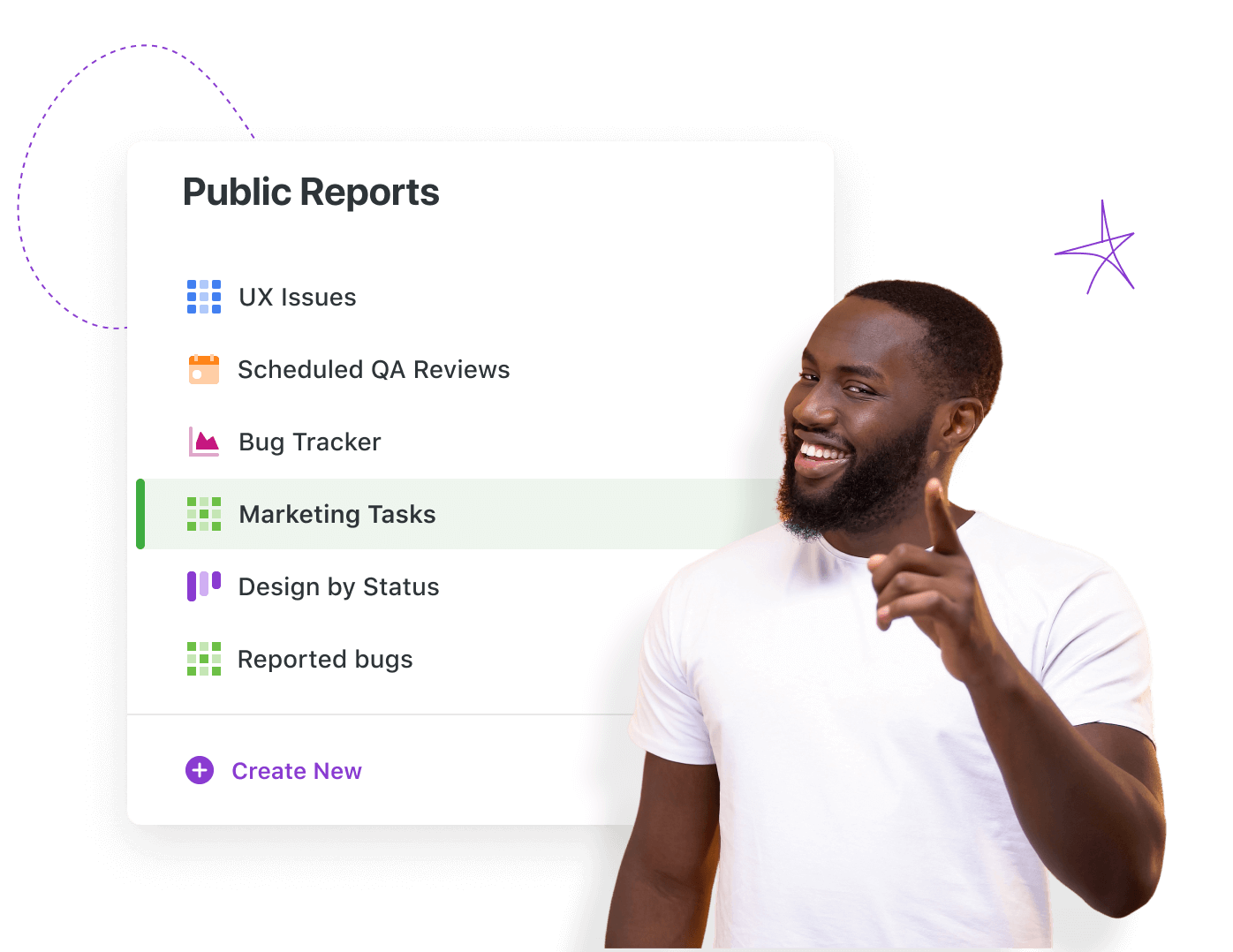
Your team can visualize reporting in Grid, Card, Kanban, Timeline, Map, Calendar, or Dashboard views.
It is possible to add as many as needed to build a visual storyboard for your project’s progress.
To share reports with stakeholders or clients, you can make the report public and share the necessary access.

Advanced workflow automation
SmartSuite's no-code automation builder allows teams to automate some of the repetitive tasks that you’re facing in your day-to-day operations.
For example, you can assemble automation at the task and project and automate repetitive tasks based on triggers like changing dates, sending notification emails, or updating statuses.
There are six pre-defined triggers and 15+ actions, with options to build custom ones.
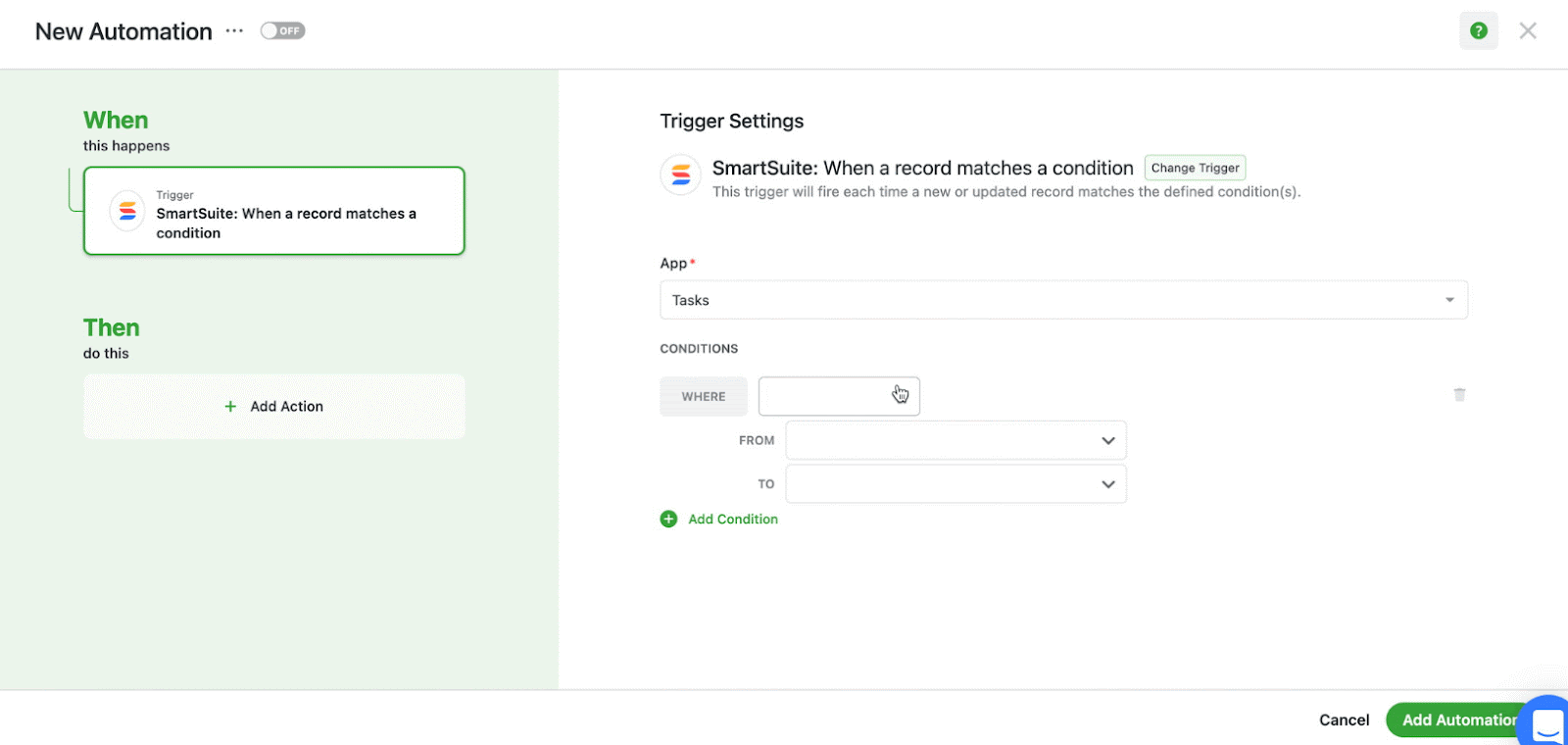
Once you’ve set up a workboard in SmartSuite, head to “Automations” and automate anything from record creation to updates to task assignments and notifications.
SmartSuite Pricing
Unlike Jira, SmartSuite offers a generous free plan that lets you access the platform’s advanced functionality with access to 250+ automation actions, team collaboration, multi-dashboard views, and more.
There are four paid plans with a 14-day free trial:
- Team: Starts at $10/user per month, including Gantt charts, timeline views, 5000 automation runs, and time tracking.
- Professional: Starts at $25/user per month and adds two-factor authentication, Gmail & Outlook integrations, and unlimited editors.
- Enterprise: Starts at $35/user/month and includes access to audit logs, data loss prevention, and 50,000 monthly API calls.
- Signature: A customized plan tailored to your organization’s needs and team size with no predefined limits.
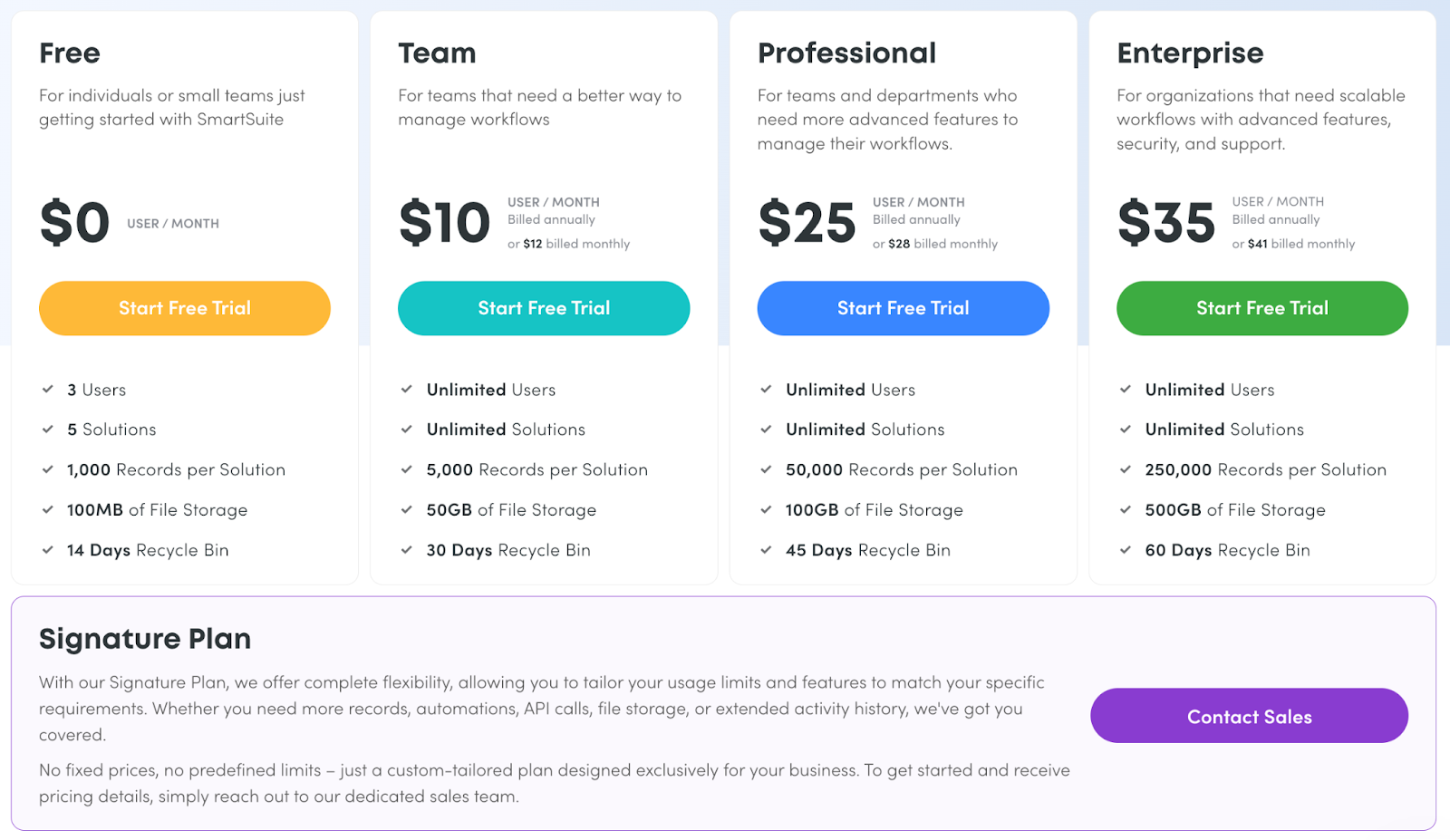
SmartSuite Pros and Cons
✅ The free plan includes access to advanced features, unlike Jira’s.
✅ 200+ project templates for various use cases.
✅ Dynamic dashboards and reporting that are easy to navigate.
✅ Integrated document and file management.
✅ Comprehensive workflow automation.
❌ Less native integrations when compared to other alternatives.
#2: Wrike
Best for: Enhancing productivity and streamlining workflows.
Similar to: Hive, Basecamp.

Wrike is a work and project management tool that enables teams to manage tasks and collaborate effectively.
Wrike is one of Jira’s alternatives that makes up for some of the tool lapses. Unlike Jira, Wrike offers users more flexibility to tailor workflows to suit their unique processes and project needs.
While Jira has best-in-class task creation, Wrike provides better project reports.
Features

- Interactive Gantt Charts: These charts provide a visual representation of project timelines to allow you to set dependencies and adjust schedules.
- Advanced Analytics and BI: Wrike lets you track your team’s performance and compare the results via its analytics dashboards.
- Real-Time Collaboration: Team members can communicate directly within tasks, share files, and provide feedback.
Standout Feature: Built-in tools for workforce planning

Wrike stood out to us with its workflow automation for balancing workloads, boosting efficiency, and maximaizing productivity.
With Wrike, you can have complete visibility into your team’s capacity and a clear picture of what resources are available.
Pricing
Wrike offers a forever-free plan that lets you get access to its basic features as well as a mobile app.
Below are details of its paid plans:
- Team: $9.80/user/month for 2 to 25 users, which adds unlimited projects, tasks, and unlimited custom fields.
- Business: $24.80/user/month for 5 to 200 users, which adds a folder structure, cross-tagging, and custom item types.
- Enterprise: Custom pricing, which adds advanced features, including enterprise-grade security and scalability.
- Pinnacle: Custom pricing, which adds more advanced tools and analytics for complex work processes.

Pros and Cons
✅ Highly customizable platform & interface, according to G2 reviews.
✅ Offers flexible automation.
✅ Good in-built reporting capabilities.
❌ Reliance on third-party communication tools for collaboration.
❌ Can have integration delays that affect automation efficiency.
#3: Monday.com
Best for: Users looking for a visually intuitive interface to manage tasks and projects.
Similar to: ClickUp, Trello.

Monday.com is a work management tool designed to help teams manage their projects and workflows effectively.
Jira offers team bug-tracking functionalities and managing software development, but Monday.com provides a highly customizable platform that allows users to tailor workflows.
Plus, it offers more automation capabilities that large teams value when managing processes from one platform.
Features

- Integrations: Offers 200+ integrations and apps to help you collaborate and work seamlessly.
- Dashboard customization: Monday enables you to build the tools you need for your operations via customizable no-code dashboards.
- High-level overview: Provides real-time insights and a detailed overview of your business.
Standout Feature: Customizable Dashboards

What stood out to us about Monday.com was its customizability of dashboards, which gives you the possibility to display and track project data in a way that works best for your team.
This way you can focus on the information that matters most and you can tailor the data and layout to fit your needs.
Pricing
Monday.com offers a free plan with limited features that lets you create up to 3 boards, four paid plans, and a 14-day free trial.
Below are details of its paid plans:
- Basic: $9/seat/month with unlimited free viewers and items.
- Standard: $12/seat/month with various view options, 250 automation and integration actions/month and guest access.
- Pro: $19/seat/month with more advanced features, including 25k automation and integration actions/ month, time tracking and private boards.
- Enterprise: Contact sales for a tailored price. Includes exclusive features like enterprise-scale automations and integrations, tailored onboarding, advanced reporting and analytics.

Pros and Cons
✅ Monday.com offers multiple customization options.
✅ No-code automation.
❌ Steep learning curve, according to verified users of G2 reviews.
❌ The pricing plans could be more affordable, according to G2 reviews.
❌ Slow loading time and constant screen lag.
#4: Basecamp
Best for: Simple team collaboration and remote work management.
Similar to: Trello, Wrike.

If you are looking for a project management tool with a less complex UI design, Basecamp could be a good option.
It is most suitable for small to medium-sized businesses looking to streamline their project workflows without a steep learning curve.
Compared to Jira, Basecamp emphasizes an intuitive, user-friendly interface, which makes it easier for teams to get started without extensive training.
Features

- Track work with to-dos: This allows you to effectively track work, responsibilities, and deadlines.
- Project Templates: Basecamp allows you to create templates for repetitive tasks and projects.
- Time sheets: Allows you to track time directly on the platform without third-party apps.
- Built-in communication tools: Basecamp enables you to communicate directly on the application, including 1:1s and group chats.
Standout Feature: Built-In Chat

Basecamp’s built-in chat function gives your team members the ability for occasional real-time communication while important asynchronous communication happens on message boards.
Pricing
Basecamp offers two paid plans and a 30-day free trial for each plan.
- Basic: $15/user/month with free access for all your guest users.
- Pro Unlimited: $349/month with unlimited user access and an option to pay annually ($299/month).

Pros and Cons
✅ Basecamp has an easy-to-use interface and is affordable.
✅ Offers built-in communication features.
✅ Has multiple visual reports.
❌ Limited integrations and automation.
❌ No built-in Gantt chart view.
#5: Asana
Best for: Organizing tasks and tracking progress through customizable project boards and real-time collaboration.
Similar to: Monday.com, ClickUp.

Asana is a go-to project management tool for teams looking for an easy-to-use platform with advanced features.
When comparing the platform with Jira, Asana stands out with its automation abilities and detailed reporting on projects. The tool enables users to eliminate repetitive tasks by setting up custom rules.
Features

- Project Views: Visualize projects in different formats, such as lists, boards, and calendars, catering to various workflow preferences.
- Reporting and Dashboards: Monitor project progress with customizable dashboards and status updates to help your team stay aligned with set goals.
- Integrations: Connect with over 200 other applications to streamline workflows and enhance productivity.
Standout Feature: AI Chat

What stood out to us most about Asana was its AI chat function, where you can ask an AI chatbot questions about your project management and it will suggest ways to improve your skills and techniques.
Pricing
Asana offers a freemium plan with generous features and two paid plans.
Below are details of Asana’s pricing plans:
- Starter: $10.99/user/month, including access to Asana AI, Gantt & Timeline view, and project dashboards.
- Advanced: $24.99/user/month with access to more advanced features like advanced reporting, time tracking and scaled security.

Pros and Cons
✅ Asana offers an intuitive and customizable interface.
✅ Offers a generous free plan.
✅ Comprehensive view of tasks and priorities.
❌ Relies on third-party tools for automation.
❌ Advanced project management features are only on paid plans.
#6: Hive
Best for: Streamlining task management and collaboration.
Similar to: Asana, Wrike.

Hive’s project management platform offers various features to help users manage tasks, communicate effectively, and track project progress.
In comparison to Jira, Hive provides more automation and in-built communication abilities. While Jira has automation features, it isn’t as robust and user-friendly.
Features

- Multiple Project Views: Hive provides various ways to visualize projects, including Kanban, Gantt, and Calendar views, allowing teams to manage their workflows according to their preferences.
- Collaboration Tools: The platform offers features for commenting, file sharing, and real-time updates, ensuring that all team members are aligned and informed throughout the project lifecycle.
- Integration Capabilities: The platform integrates with various third-party applications, making it easier to incorporate into existing workflows.
Standout Feature: Buzz AI

Hive stood out to us most with its Buzz AI assistant, which improves itself while working with your team so it can be useful for you later on.
Buzz is powered by the data and context inside your workspace while providing you with a high level of security and privacy for your data.
Pricing
Hive offers a forever-free plan with generous features. It also allows users to try out the platform via its 14-day free trial.
Here are details of its paid plans:
- Starter: $7/ user/month with unlimited storage, Gantt view, up to 10 projects and workspace members, and AI assistant.
- Teams: $18/user/month with up to 50 workspace members, unlimited workflows and time tracking.
- Enterprise: Contact sales for custom price. Includes Custom analytics & reporting abilities, enterprise API, and dedicated CSM.

Pros and Cons
✅ Hive offers a built-in AI assistant.
✅ 100+ templates for different use cases.
✅ Multiple dashboard views.
❌ Custom analytics and reporting are only available on the enterprise plan.
❌ Limited native integration with heavy reliance on Zapier.
#7: Notion
Best for: Documentation, project planning, and team communication.
Similar to: Coda.

Notion provides an all-in-one workspace that allows teams to collaborate, organize, and manage projects and tasks effectively.
The platform’s documentation board and project management features offer an interesting alternative to Jira for companies who want documentation and task management in one interface.
Features

- Custom Dashboards: Allows you to build personalized dashboards for tracking project metrics, deadlines, and overall progress at a glance.
- Task Management: Notion supports Kanban boards and to-do lists to allow you to track tasks and monitor statuses effectively.
- Templates: Notion provides various templates for project planning, task tracking, and goal setting.
Standout Feature: Notion Wiki

What stood out to us most about Notion AI is its Notion Wiki function, which allows you to create a centralized knowledge base within Notion.
It enables teams to organize and share information effectively.
Pricing
Notion offers a freemium plan with unlimited pages and blocks and guest collaboration for up to 10 individuals.
Below are details of its paid plans:
- Plus Plan: $10/seat/month, features unlimited file uploads, 30-day page history, and allows up to 100 guest collaborators.
- Business Plan: $15/seat/month, adds advanced features like 90-day page history and up to 250 guest collaborators.
- Enterprise Plan: Custom pricing. Offers more advanced features like workspace analytics, unlimited history, and CSM.

Pros and Cons
✅ Notion AI offers versatile and customizable workflows.
✅ Great as a knowledge base.
✅ Has an intuitive interface that is easy to navigate.
✅ Cross-platform accessibility–available on the web, desktop, iOS, and Android.
❌ Limited process automation features.
❌ Lack of advanced project management features.
#8: ClickUp
Best for: Managing all work tasks in one place.
Similar to: Asana, Monday.com.

ClickUp is a project management solution that suits businesses of all sizes, including startups, SMBs, and large enterprises.
While Jira is considered user-friendly, an intuitive and flexible UI is ClickUp’s main selling point.
Features

- Customizable Workflows: Enables you to tailor your workflows with custom statuses, templates, and views (list, board, calendar, Gantt, and others.)
- Integrations: Integrates with various third-party apps like Slack, Google Drive, and others.
- ClickUp Brain: Provides an AI to help you automate work processes.
Standout Feature: Prioritizing Tasks

What stood out to us about ClickUp was its prioritization of tasks function by using five different priority levels.
With levels ranging from low to urgent, each priority is color-coded, so you and your team can easily identify and act on tasks that need your attention now.
Pricing
ClickUp offers a freemium plan with real-time chat, unlimited tasks, multiple view options, and much more.
Below are details of its paid plans:
- Unlimited: $7/user/month with unlimited integrations, dashboards and custom fields.
- Business: $12/user/month with everything in the unlimited plan and advanced features like advanced automations, time tracking, and unlimited team access.
- Enterprise: Contact sales for pricing. Offers more advanced features like advanced permissions, enterprise API and live onboarding training.

Pros and Cons
✅ ClickUp offers advanced customizations, even on low-tier plans.
✅ Generous free plan.
✅ 100+ automation templates.
❌ Lacks process automation features.
❌ Can become messy as you reach 100+ users, according to G2 reviews.
#9: Trello
Best for: Visual task organization and collaboration.
Similar to: Asana, ClickUp.

Trello is a project management tool that utilizes a visual approach to organize tasks, primarily through the Kanban method, which is simple, flexible, and affordable.
The platform allows users to create boards, lists, and cards to manage projects and workflows effectively.
Features

- Customizable Lists: Trello allows you to customize columns to break projects into smaller parts. You can choose to rename, reorder, or delete these lists, which provides flexibility.
- Power-Ups and Integrations: Trello offers Power-Ups to allow you to add extra functionalities to your boards. Trello also integrates with tools like Slack, Google Drive, and GitHub for effective team collaboration.
- Views: The platform provides several view options, including dashboard, table and map views to help you have various pictures of your projects and tasks.
Standout Feature: Boards

What stood out to us most about Trello was its visualization feature, which creates boards for better visualization of your tasks.
Each board represents a project or initiative, bringing everything you need into an organized space.
Pricing
Trello offers a free plan and a 14-day free trial for its paid plans.
Below are details of its paid plans:
- Standard: $5/user/month with advanced checklists, custom fields and unlimited board.
- Premium: $10/user/month with workspace-level templates, data export options, comprehensive view options and AI.
- Enterprise: $17.50/user/month for more advanced features like unlimited workspaces, power-Up administration, organization-wide permissions and others.

Pros and Cons
✅ Trello has a user-friendly and intuitive dashboard.
✅ Ease of access and adaptability to various screen sizes.
✅ Built-in automation.
❌ Lack of seamless working across multiple boards, according to G2 reviews.
❌ Need third-party integrations (which are paid).
#10: Workzone
Best for: Teams looking to improve their project management and collaboration processes.
Similar to: Hive, Trello.

Workzone is a project management software designed to help teams manage projects effectively.
Unlike Jira, it provides detailed workload reports and real-time status alerts to help project managers track project progress and resource allocation.
Features

- Budget Management: Tools for project budgeting, cost tracking, and ROI forecasting.
- Customizable Reporting: Offers tools for generating reports tailored to specific project needs, helping teams track progress and performance.
- Task and Resource Management: Users can create tasks, assign them to team members, and manage resources efficiently to ensure project deadlines are met.
Standout Feature: Customizable Task Management

What stood out to us most about Workzone was its customizable task management function, which can create tasks and manage resources so the work process is efficient.
Pricing
Workzone offers three main pricing plans including:
- Team Plan: $24/user/month, suitable for teams of five or more, includes project templates, Gantt chart, automated to-do list and other features.
- Professional Plan: $34/user/month, designed for larger teams, with enhanced features like unlimited workspaces, advanced reporting and resource management.
- Enterprise Plan: Custom pricing for larger organizations. Offers endless customization features.

Pros and Cons
✅ Provides you with robust reporting.
✅ Offers a variety of customizable templates.
✅ Granular access management and permissions.
❌ No free plan.
❌ Clunky interface, according to verified users on G2.
What’s The Best Jira Alternative?
We’ve reviewed the best Jira alternatives available and seen each tool’s strengths and drawbacks.
At this point, you have what you need to choose the tool that will meet your team’s project management needs.
SmartSuite and Jira are both all-in-one solutions that can handle work management and process automation, but SmartSuite has the upper hand in collaboration options and ease of use.
Hive and Workzone specialize in project management for teams with more traditional needs, while Notion and Monday.com offer light and visual alternatives.
Try SmartSuite today for free if you are looking for a Jira alternative with:
- Best-in-class reporting.
- Extensive workflow automation.
- Advanced real-time collaboration.
- An easy-to-use platform with an intuitive interface.
- A generous free plan that lets you get to know the platform first before committing to a paid plan.
All of this is done in a powerful yet simple interface that everyone within the organization will love to use daily.














.jpg)









